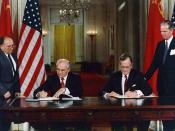The collapse of the Soviet Bloc, and subsequently the Soviet Union between 1989 and 1991 was dramatically played out on our TV screens. For 40 years the Soviet Union had been the evil 'other' of Western liberal democracies, and Cold War politics affected not only politicians but also all members of society who lived constantly under the threat of nuclear annihilation, to the effect that it became 'part of the furniture' of the structure of the world order. The disillusion of the Soviet Bloc, and Cold War politics seemed to herald the vindication of the capitalist liberal democratic societal model and, as it turned out, contributed to a more fragmented, less predictable world. A discussion of the influences and events which lead up to the demise of the Soviet Union and the conclusion of Cold War tensions is enormously complex and it is necessary to limit the scope of this paper to a discussion of the Soviet model and why the economic, social and political reforms carried out by Mikhail Sergeivich Gorbachev in the second half of the 1980's ultimately contributed to the demise of the system.
It is first necessary to define the key characteristics of the structure of the Soviet model, and the key ideological influences, which dictated this structure. The Soviet model was essentially a totalitarian model, which is characterised by strong central rule that attempts to control and direct all aspects of individual life through coercion and repression. This central rule is implemented to ensure that the postulated 'preordained, harmonious and perfect scheme of things, to which men are irresistibly driven' is achieved, and it was thus ideologically legitimised (Talmon 1961) (pg 1). It recognises ultimately only one plane of existence, the political. The totalitarian democratic school of thought 'widens the scope of politics...


